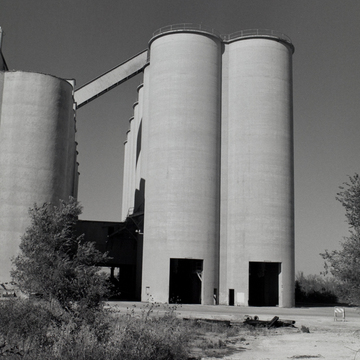The image of concrete cylindrical silos has been one that has continually enticed the exponents of modern architecture, from Wright to LeCorbusier, as well as such American School painters as Charles Sheeler and Charles Demuth. This impressive array of 26 units was designed for the storage of cement, not grain. In the early 1920s, 6 units 33 feet high were constructed on the site. These were eventually joined by even higher units reaching up to 110 feet. Their construction is that of reinforced concrete using the slip-form method of building. Originally there was a cement manufacturing facility that accompanied the silos, but this is now gone. The silos are currently operated by the Iowa Concrete Company, headquartered in Davenport. The dry cement is manufactured at Buffalo, Iowa, and shipped to these storage silos for use in the Des Moines area.
You are here
Pyramid Cement Company Storage Units
If SAH Archipedia has been useful to you, please consider supporting it.
SAH Archipedia tells the story of the United States through its buildings, landscapes, and cities. This freely available resource empowers the public with authoritative knowledge that deepens their understanding and appreciation of the built environment. But the Society of Architectural Historians, which created SAH Archipedia with University of Virginia Press, needs your support to maintain the high-caliber research, writing, photography, cartography, editing, design, and programming that make SAH Archipedia a trusted online resource available to all who value the history of place, heritage tourism, and learning.

